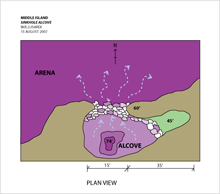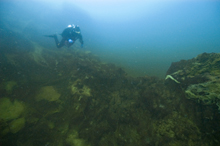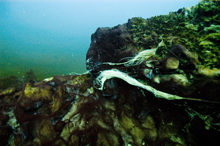Researchers are exploring extreme conditions for life in a place not known for extremes. Click image for larger view and image credit.
The scientists report that some deep sinkholes act as catch-basins for dead and decaying plant and animal matter and also collect a gelatinous, black sludge often topped by a bacterial film. In the oxygen-depleted water, cyanobacteria carry out photosynthesis using sulfur compounds (rather than water) and give off hydrogen sulfide — the gas associated with rotting eggs. Click image for larger view and image credit.
Mission Summary
September 2 – 12, 2008
Steve Ruberg
Principle Investigator – Thunder Bay Sinkholes
NOAA Great Lakes Environmental Research Lab
Winter is now approaching in the Great Lakes. The high winds and cold temperatures have ended our field work for the year. Our data collection efforts have given way to sample processing and data analysis until we can resume field data collection this coming spring. We obtained sensor measurements and collected samples at nearshore El Cajon and the Middle Island Sinkhole system and the offshore Isolated Sinkhole system during the summer and fall. Sensor observations and diver observations have given us insight into the physical, biological, and chemical characteristics of the sinkholes. Sample processing continues to reveal the way life in these extreme systems behaves, as well as to provide hopeful insights into the potential value of these organisms for use in pharmaceutical applications. We have also begun to publish some of our results in scientific journals.
Tom Johengen's Lab collected nutrient samples from all three sinkhole locations during three different surveys. The goal was to sample the groundwater end member as well as comparative control (lake water) samples at each of the sinkhole sites. Samples will be analyzed for a variety of nutrients, including nitrogen, phosphorous, and silicon as well as other ions (such as chloride, sulfate, bromide, and fluoride). Chemical analyses will help to define the signatures (i.e., source and strength) of the groundwater input and will be examined in terms of its potential influence on observed levels of photosynthesis and chemosynthesis present within the sinkhole basins.
Bopi Biddanda's Lab ![]()
![]() focused on sinkhole ecosystem ecology, characterizing the chemical, physical, and hydrographic features; measuring water, benthic mat and sediment metabolism; and providing insight into the food web linkages between sinkhole ecosystems and the lake. Collectively, we developed methods to describe the abundance, diversity, and activities of the sinkhole microbial communities. Although the purple benthic mat consisted mostly of Oscillatoria-like cyanobacteria, microscopic examination (and molecular level phylogenetic analyses by the Nold Lab) has revealed the presence of active nematodes, tardigrades, arthropods, and various protozoa — confirming that the mats are a complex and dynamic consortia of microbial producers and protozoan and metazoan consumers.
focused on sinkhole ecosystem ecology, characterizing the chemical, physical, and hydrographic features; measuring water, benthic mat and sediment metabolism; and providing insight into the food web linkages between sinkhole ecosystems and the lake. Collectively, we developed methods to describe the abundance, diversity, and activities of the sinkhole microbial communities. Although the purple benthic mat consisted mostly of Oscillatoria-like cyanobacteria, microscopic examination (and molecular level phylogenetic analyses by the Nold Lab) has revealed the presence of active nematodes, tardigrades, arthropods, and various protozoa — confirming that the mats are a complex and dynamic consortia of microbial producers and protozoan and metazoan consumers.
An interesting scientific finding was that the 14C-bicarbonate uptake studies of production processes showed that sinkhole ecosystems are variably supported by oxygenic photosynthesis, anoxygenic photosynthesis, and chemosynthesis along a depth gradient of decreasing sunlight. Further stable isotope studies showed that the local benthic food web is tightly linked to carbon input from the groundwater. Additional microscopy of biological samples and analyses of carbon and nutrient content of water samples collected during 2008 remain to be performed.
Steve Nold's Lab is providing an understanding of microbial ecology by characterizing the fine-scale vertical organization of multi-celled animal communities inhabiting the sinkholes and determining the source of organic carbon in sinkhole sediments. We collected and thin-sectioned sediment cores from Middle Island Sinkhole and extracted and separated phospholipids from the cell membranes of sinkhole inhabitants. These samples are currently at the Soil Science Department at the University of Wisconsin–Madison awaiting analysis. They will be separated by gas chromatography, and individual lipid components will be analyzed by isotope ratio mass spectrometry for 13C content. These data will provide a comprehensive view of microbial community composition, including metazoan and bacterial inhabitants. By illuminating patterns of 13C incorporation into individual membrane lipids, these data will also link metazoans to their food source (presumably the cyanobacterial phototrophs in this ecosystem).
The source of organic carbon in sinkhole sediments was discovered by collecting sediment, phytoplankton, cyanobacterial mat, sedimenting carbon, and dissolved inorganic carbon samples from Middle Island Sinkhole. We analyzed the 13C and 15N content of each carbon pool, using isotope ratio mass spectrometry. Nearly all (more than 90%) of the carbon in sinkhole sediments originates from the sedimenting phytoplankton rather than the overlying cyanobacterial mat. Upcoming analyses will focus on the diversity and abundance of microbes inhabiting Isolated Sinkhole, a 93-meter (305-foot) deep feature offering an aphotic environment possibly supported solely by chemosynthesis.

As little as 20 meters (66 feet) below the surface of Lake Huron, the third largest of North America's Great Lakes, peculiar geological formations — sinkholes made by lake water dissolving parts of an ancient underlying seabed — harbor bizarre ecosystems where the fish typically found in the huge freshwater lake are nowhere to be seen. Click image for larger view and image credit.
Mark Baskaran's Lab collected a suite of water samples in around the three vents. Radioisotopes and stable isotopes of oxygen and hydrogen were analyzed in these water samples. We found the radium isotopes give the groundwater a unique isotopic signature with 100 more times radium in the sinkhole groundwater than in the surrounding lake water. We will be able to quantify the amount of submarine groundwater discharge into the lake using this unique signature. The analysis of stable isotopic oxygen indicated that the sinkhole water is highly depleted in oxygen isotopic composition. The hydrogen isotopic composition also indicates similar depletion. When the analysis is completed on additional radium isotopes we anticipate obtaining the velocity of the movement of sinkhole water into the lake, using isotopic activity ratios. We also anticipate obtaining the vertical and horizontal diffusion rates of sinkhole water, using the concentration gradient of radium isotopes.
Sediment and microbial mat samples are also being analyzed for potential use in treating a wide variety of diseases. Cyanobacterial mat samples from the Middle Island Sinkhole provided to David Sherman's Lab ![]()
![]() at the University of Michigan (UM) were analyzed by a multidisciplinary team of investigators at the UM's Life Sciences Institute, Argonne National Laboratory, and the University of Chicago. The team of researchers reported the discovery of a new target against the deadly human pathogen anthrax that could provide access to effective antibiotic therapies. The bacterium that causes anthrax, a bioterror agent that again came to notoriety during the 2001 “anthrax scare,” has been the subject of intensive research to develop effective vaccines and new drugs to rapidly treat infection.
at the University of Michigan (UM) were analyzed by a multidisciplinary team of investigators at the UM's Life Sciences Institute, Argonne National Laboratory, and the University of Chicago. The team of researchers reported the discovery of a new target against the deadly human pathogen anthrax that could provide access to effective antibiotic therapies. The bacterium that causes anthrax, a bioterror agent that again came to notoriety during the 2001 “anthrax scare,” has been the subject of intensive research to develop effective vaccines and new drugs to rapidly treat infection.
Project lead investigator Steve Ruberg, along with Rob Paddock of the University of Wisconsin–Milwaukee Water Institute ![]()
![]() and Scott Kendall of the Annis Water Resources Institute
and Scott Kendall of the Annis Water Resources Institute ![]()
![]() collected imagery and chemical and physical mapping data at all three sinkhole locations, using remotely operated vehicles. High resolution bathymetric maps have now been produced of all three sinkhole locations. Visualization maps of dissolved oxygen, pH, temperature, and conductivity will be produced for all three sinkhole systems. Observations obtained during the summer and fall research cruises are leading to additional investigations and insights valuable to our understanding of these unique environments. The deeper Isolated Sinkhole has a higher conductivity level than the Middle Island system, potentially due to the higher salt content contributed by evaporated seawater captured in rock layers of the Silurian period during the Paleozoic era. Remotely operated vehicle (ROV) observations have led to a better understanding of the sources of groundwater in the Middle Island system. Our initial conclusion that the bowl-shaped Alcove was the primary source of groundwater is now being re-evaluated, with the discovery of multiple sources around the base of the Arena walls.
collected imagery and chemical and physical mapping data at all three sinkhole locations, using remotely operated vehicles. High resolution bathymetric maps have now been produced of all three sinkhole locations. Visualization maps of dissolved oxygen, pH, temperature, and conductivity will be produced for all three sinkhole systems. Observations obtained during the summer and fall research cruises are leading to additional investigations and insights valuable to our understanding of these unique environments. The deeper Isolated Sinkhole has a higher conductivity level than the Middle Island system, potentially due to the higher salt content contributed by evaporated seawater captured in rock layers of the Silurian period during the Paleozoic era. Remotely operated vehicle (ROV) observations have led to a better understanding of the sources of groundwater in the Middle Island system. Our initial conclusion that the bowl-shaped Alcove was the primary source of groundwater is now being re-evaluated, with the discovery of multiple sources around the base of the Arena walls.
In addition, Nathan Hawley ![]() deployed 12 instrumented moorings near the Middle Island and Isolated sinkholes to determine how groundwater ionic composition and physical parameters (such as temperature and flow rate) vary with local climate and lake conditions over the course of a nine month multi-sensor deployment.
deployed 12 instrumented moorings near the Middle Island and Isolated sinkholes to determine how groundwater ionic composition and physical parameters (such as temperature and flow rate) vary with local climate and lake conditions over the course of a nine month multi-sensor deployment.




















